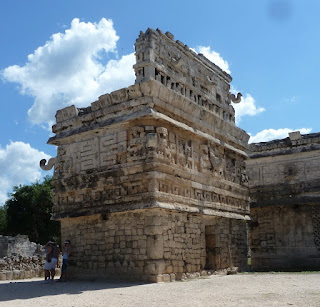 |
| Russ, Scott and I had the Pyramid of Kukulcan (or El Castillo) |
This was huge city built on a leveled paved platform of 1.9 square miles. Outside of this ceremonial center were the homes of the Mayans themselves. It was active from about 600 AD to 1200 AD and encompasses three Mayan architectural styles; Late, Terminal and Post Classic. I found really interesting the combination of Mayan and Toltec gods and symbols. Our guide felt it showed the political truce between these two cultures.
 |
| Excavations below the huge terrace around the structures now visable show additional levels below |
 |
| All the buildings are covered with bas relief sculpture and statues |
 |
| The Platform of the Eagles and Jaguars depict these animals grasping human hearts in their claws |
 |
| Alfredo, our guide, was very knowledgeable and added a lot of interesting details to our visit. |
 |
| The Temple of the Warriors with the "Thousand Columns" stretching out in front and to the north. Inside is the earlier Temple of Chac -Mool and a statue of Chac-Mool is still on top. |
 |
| Many of the columns are carved with figures of warriors |
 |
| The Ossuary or the Bonehouse known for it's beautiful serpent's heads at the base of the staircase |
 |
| El Caracol (the Snail, called by the Spaniards because of it's interior spiral staircase) was an Observatory. The windows are aligned with certain stars on particular dates. |
We were starved and thirsty so we quickly found a nearby restaurant with a buffet. The food was all right, the drinks cold and they had a folk dancing demonstration. Life was much better. Our next stop was another refresher. The Yucatan is filled with cenotes - limestone underground fresh water pools. Some were ceremonial. There was one at Chichen Itza connected to El Castillo by a highway and it was the focus of sacrificial ceremonies. Another nearby provided water for the city.
We went south to Cenote Dzitnup, just north of Valladolid. The local farmer's coop has built a visitor center and changing rooms there. They charge a nominal admission. You descend carved stone stairs into the earth and emerge in a cavern with stalagmites hanging down over the clear pool. A small hole in the ceiling provides some natural light and a few artificial lights around the edge make it a little easier to get safely into the water. We joined a crowd of mostly local people enjoying the cool water.
This sure made it easier to get back in the car and make the long drive to Cancun. We arrived just after sunset, grabbed a bite to eat and caught the 8:30pm ferry back to Isla Mujeres. We won't be spending much time in Cancun. It's a long strip of huge hotels, condos, restaurants (all too many American chains). The beach is really beautiful we hear and this is obviously a lovely and popular vacation destination, but it's too much like Florida for us. We prefer a low key, low rise Mexican feeling, like our Isla Mujeres. It was a long but really interesting fun two day trip but we wished we'd had a week instead.
 |
| This young man demonstrated the natural dyes which are used on the cypress carved masks, one of which we bought for our grandson Daniel. |
 |
| Embroidered dresses are worn by many of the Mayan descendants in this region. See the young girl below. We bought one for granddaughter Maya. |
 |
| A demonstration of local folk dances during our lunch. |
 |
| This lovely young Mayan girl was taking good care of her baby sister. She's wearing a traditional embroidered dress with a lace petticoat showing (deliberately) below. |
 |
| Another more modernly dressed family sits nearby. |




No comments:
Post a Comment